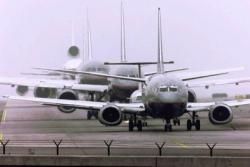Program Allows Airlines To Fly Around Storms
 Airline delays were bad
enough this past winter, as hundreds of passengers were forced to
become intimately acquainted with the interiors of MD-80s, 737s,
A320s, and other aircraft for hours on end, waiting out storms on tarmacs
at airports throughout the country. Now imagine the same scenario,
but also with summertime temperatures to contend with.
Airline delays were bad
enough this past winter, as hundreds of passengers were forced to
become intimately acquainted with the interiors of MD-80s, 737s,
A320s, and other aircraft for hours on end, waiting out storms on tarmacs
at airports throughout the country. Now imagine the same scenario,
but also with summertime temperatures to contend with.
In a step toward avoiding this vertiable hell on earth, the
Federal Aviation Administration (FAA) is expanding an air traffic
program aimed at reducing flight delays during the peak summer
travel -- and thunderstorm -- season.
The Airspace Flow Program, as it is known, gives airlines the
option of either accepting delays for flights scheduled to fly
through storms... or flying longer routes to maneuver around
them.
The agency launched the program last year at seven locations in
the Northeast. On bad weather days at major airports in the region,
delays fell by nine percent compared to the year before, according
to the FAA. Cost savings for the airlines and the flying public
from the program are estimated to be $100 million annually.
"This is a much better way to handle summer traffic," said FAA
Administrator Marion C. Blakey. "If your flight isn’t
scheduled to fly through bad weather you don’t have to sit on
the tarmac. If it is, your airline has the choice of taking a delay
shared evenly by all the affected flights, or flying around the
storm."
In theory, airlines would accept the delay before putting
passengers on the plane, and departing the gate... meaning
travelers would still be stuck at the airport, but they'd have a
tad more breathing room (and adequate bathroom facilities.)
 Before last year, severe
storms often forced the FAA to ground flights at affected airports,
penalizing flights not scheduled to fly through them. This program
allows the FAA to manage traffic fairly and efficiently by
identifying only those flights scheduled to fly through storms and
giving them estimated departure times. In turn, the airlines have
greater flexibility in planning schedules with less disruption for
passengers.
Before last year, severe
storms often forced the FAA to ground flights at affected airports,
penalizing flights not scheduled to fly through them. This program
allows the FAA to manage traffic fairly and efficiently by
identifying only those flights scheduled to fly through storms and
giving them estimated departure times. In turn, the airlines have
greater flexibility in planning schedules with less disruption for
passengers.
This summer, the number of Airspace Flow Program locations --
chosen for their combination of heavy traffic and frequent bad
weather -- will be expanded from seven to 18. The FAA says the
additional locations will ease delays for passengers flying through
the South and Midwest, as well as those on transcontinental
flights.
Also, what the FAA terms "dynamic" programs will be introduced
in other areas to target storms with surgical precision as they
develop and move. Airspace Flow Programs will also be used in
conditions not related to weather, such as severe congestion near
major cities.
Airspace Flow Programs were conceived by the FAA two years ago
and developed in close coordination with the airline industry. On
bad weather days, agency and airline officials collaborate to
decide where and when the programs should be put in place.
In another development, on Wednesday the FAA announced out a new
software program that ensures airports impacted by bad weather
receive the maximum number of flights that can safely fly to them.
During storms, arrival slots often open up due to delayed or
canceled flights. The new software program, called Adaptive
Compression, automatically fills those slots with the next
available flight.
The software tool, which was launched in March, is designed to
reduce delays, saving time and money for the airlines and
passengers.
 ANN's Daily Aero-Linx (04.16.24)
ANN's Daily Aero-Linx (04.16.24) Aero-News: Quote of the Day (04.16.24)
Aero-News: Quote of the Day (04.16.24) Airborne 04.10.24: SnF24!, A50 Heritage Reveal, HeliCycle!, Montaer MC-01
Airborne 04.10.24: SnF24!, A50 Heritage Reveal, HeliCycle!, Montaer MC-01 Airborne 04.12.24: SnF24!, G100UL Is Here, Holy Micro, Plane Tags
Airborne 04.12.24: SnF24!, G100UL Is Here, Holy Micro, Plane Tags Airborne-Flight Training 04.17.24: Feds Need Controllers, Spirit Delay, Redbird
Airborne-Flight Training 04.17.24: Feds Need Controllers, Spirit Delay, Redbird




